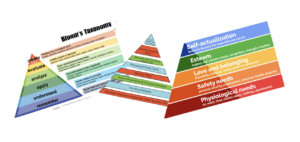Communication. We need it in life, we need it in school. It is vital to classroom success. Without it, a successful journey through school, and life, is hard. To communicate we need to be able to hear and see and we need our brains to process what we hear and see. We also need to be able to write with skill.
Communication depends on lots of big-body, physical play. Without it, the body does not get strong enough to communicate, and the brain does not learn, through the movement of the body, how to interpret the cues of the world around it.
Shut the front door. What does this mean?
Last month’s newsletter focused on auditory processing and drew the connection between a sedentary lifestyle and poor auditory processing. As we noted, auditory processing depends on a well-developed vestibular system which comes about through big-body physical play in the form of spinning, swinging, sliding, hanging upside down, and logrolling. Without this physical movement, the brain does not develop the data processing system needed to filter the important sounds we hear from the unimportant. This impacts not only a child’s ability to listen to his teacher and attend in the classroom but his safety as well. If you missed it, no worries, check it out here.
But communication depends not only on hearing and processing sound but seeing. Without vision, reading and writing are challenging. To facilitate this process, kids need to have a strong focal point so they can see words on a page, and they need to have eye-hand coordination to move a pencil.
A little developmental backstory first.
The shape of a child’s eye is very different from that of adults. Up until age 6-7 the eye is functionally farsighted, seeing objects in the distance more clearly than objects up close.* So looking at pages in a book is harder than looking outside at trees, playgrounds, a ball, or bubbles. A young child’s eye shape also makes seeing two-dimensionally much more difficult than seeing three-dimensionally, so desk work, screens, and books are harder for them to see than what they would see outdoors.**
And the thing is, we can’t change this. We can’t make the eye change shape faster so 3D and near vision are more available.
But what do we do? Ignore what is developmentally appropriate.
Intentionally or not, previous generations did not learn to read until 1st or 2nd grade, taking advantage of these developmental facts. But today, not only does our education system applaud reading in kindergarten, but it actively pushes literacies down into early education that require more of the eye than the eye is designed to do.
So when it comes to education, we are asking our children to do more than they are equipped to do.
And after school, it is no different.
We all know kids have access to an unending supply of screen-based content. This makes kids still, upright, and indoors.
But consider the ramifications on vision and ultimately, communication. A child’s eye needs sunlight to hit the retina to release dopamine in the eye. This helps to prevent the eye from elongating too much during the early years of growth. When it is elongated too much, it causes near-sightedness. Equally, the Vitamin D children absorb in outdoor time smooths the muscle tissue around the lens of the eye and helps focus light on the retina which can contribute to the proper development of the shape and length of the eye. So children need ample outdoor time to release this juicy neurotransmitter and absorb this needed vitamin to curb myopia. Equally, when children spend time outdoors, their eyes have to focus on things that are further than an arm’s length away. These distant views also help curtail the onset of near-sightedness, likely by leaning into their natural 3-D and distance vision. Again, this is not possible in time spent with screens.
Speaking of focus, communication requires we read and write which depends on a focal point to see letters and numbers on the page of a book. A child gains a strong focal point by moving his body so that his eyes must constantly shift and focus on something that is still so they can tell the brain the world is not moving, it is the body that is moving. Repeated over and over not only do the eye muscles get stronger, but the focal point becomes well-honed. That means when it is time to read and write, the letters will stay still on the page. A child who has not moved his body by spinning, swinging, sliding, hanging upside-down, and log-rolling will see letters and numbers jumping on the page making it very hard to learn to read and write.
What’s more, writing depends on strong hands and arms, a strong core to move hands and arms, and eye-hand coordination. Kids don’t hit the gym, nor would we expect them to, so big-body physical play is their workout. When they are climbing, digging, swinging, carrying buckets of sand, or moving hay bales or tires they are building, hand, arm, and core strength that will make writing easier to tackle. When they are popping bubbles, hitting a piñata, or whacking a tennis ball they are building that vital eye-hand coordination that will help them write without frustration because their brains will understand how to move their hands to create letters, words, and sentences.
It boils down to this. Without ample time in big-body physical play, children will not develop the strengths and skills they need for an easy or successful classroom journey. We know this gap in physicality is not being filled after school. So it remains incumbent on schools to fill the gap to honestly and truly educate our children in a developmentally appropriate way.
Let’s get out of the way and let kids play.
*Gallahue, D & Cleland Donnelly, F (2003) Developmental physical education for all children (Fourth ed)). Champaign, IL: Human Kinetics
**Hannaford, Carla. Smart Moves. Great River Books, Salt Lake City, UT. 2005 p 117
Don’t worry! You haven’t missed out on the good stuff!

Help Parents Understand What You Know
We are humans. We don’t know what we don’t know. And no one knows until we tell them. Spark a conversation with the adults in your student’s lives with our posters. Designed to help you help them know why big-body play is more than just play, but is vital to a positive classroom experience. Learn more here.

Did you know there is a gap between Maslow’s and Bloom’s?
Yep. But every time you get kids moving in big-body, physical play, that gap is being filled. Learn more and find out why it is so important to help other adults in our student’s world know why moving is so important to their learning trajectory. Check it out here.

